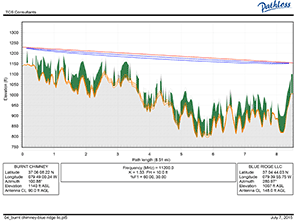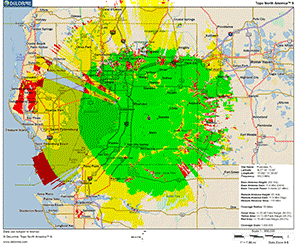Wireless RF & Microwave Design
 TCS Consultants, Inc. provides wireless consultation services specializing in
microwave design and 2-way coverage prediction. TCS has been performing these
services for over 30 years and assists manufacturers, suppliers, cellular,
energy & gas, government, and military entities in getting the most out of
their resources and budgets.
TCS Consultants, Inc. provides wireless consultation services specializing in
microwave design and 2-way coverage prediction. TCS has been performing these
services for over 30 years and assists manufacturers, suppliers, cellular,
energy & gas, government, and military entities in getting the most out of
their resources and budgets.
Established in 1984 under the name Technical Communications Software and then in 1995
under TCS Consultants, Inc. - TCS has been performing these services for more than
three decades.
TCS has been performing microwave feasibility studies, physical path surveys,
optimization design, licensing, and implementation for as long as it's been in
business. Using state-of-the-art equipment, software, and automated web-service
interconnects - TCS can quickly and accurately design single hop internet
interconnects to cross country, multiple OC3 long-haul microwave systems. Using
integrated custom design software and databases developed in-house - TCS provides
faster turn-around, more accurate results, at less cost to it's customers.
TCS provides radio frequency coverage prediction analysis as one of it's primary
services. Providing reliable and accurate coverage prediction from decades of
experience in the 2-way and telemetry industry. TCS has a proven track-record
of providing both measurable success in coverage prediction and quick response
in providing these services and products to our customers. Typical results are
completed and delivered in 1 business day via electronic delivery.
From creating brochures, bids, or presentations to preliminary feasibility studies of
proposed 2-way or telemetry system to analyzing potential anomalies in existing
systems - TCS provides these services with quick and professional turn-around.
A Brief History of TCS
 TCS Consultants, Inc. has been performing wireless consultation services for
over 30 years. Starting as technical communications software developers, (TCS),
created some of the first available wireless design software in the industry. This
included microwave path design, height above average terrain, USGS map-cross software
(before there were digital maps available), a 1st to 5th order inter-modulation
calculator, and mobile coverage analysis used for VHF, UHF, conventional and
trunked radio systems, and SCADA / Telemetry applications.
TCS Consultants, Inc. has been performing wireless consultation services for
over 30 years. Starting as technical communications software developers, (TCS),
created some of the first available wireless design software in the industry. This
included microwave path design, height above average terrain, USGS map-cross software
(before there were digital maps available), a 1st to 5th order inter-modulation
calculator, and mobile coverage analysis used for VHF, UHF, conventional and
trunked radio systems, and SCADA / Telemetry applications.
In the late 80s, TCS Consultants, Inc. moved from designing software to actually
performing the services that our software provided. TCS was being contracted to provide
a number of wireless services but specialized in microwave path surveys, FCC licensing
assistance, training, and providing radio coverage prediction for 2-way systems and
telemetry.
During the 90s, TCS officially terminated it's commercially available software products
and focused on both consulting of wireless system designs using CTE's Pathloss
software and began it's venture into actually installing and maintaining these
systems. From the 90s to 2008, TCS installed and maintained countless microwave,
2-way radio, structures, lighting, telemetry and their associated antenna and
hardware systems. While TCS did terminate it's commercial software division,
those developers continued to work and moved to creating support systems for the
design and implementation of the company. From creating digital support documents
for customers to custom interconnected databases for internal and external
use. The custom software is still one of our greatest assets.
Today, TCS Consultants, Inc. has minimized it's footprint and has moved back closer
to it's roots of microwave path design and coverage prediction. The company did
not feel that the potential risks involved in physical elevated services was
appropriate.
TCS Consultants, Inc. prides itself on providing the fastest service possible while
maintaining the highest standards of accuracy and precision. This is done through
decades of research into state-of-the-art equipment, building on our rich
foundation of custom in-house developed software, and adapting new technologies,
resources and time-reducing advancements to our design and implementations
procedures.